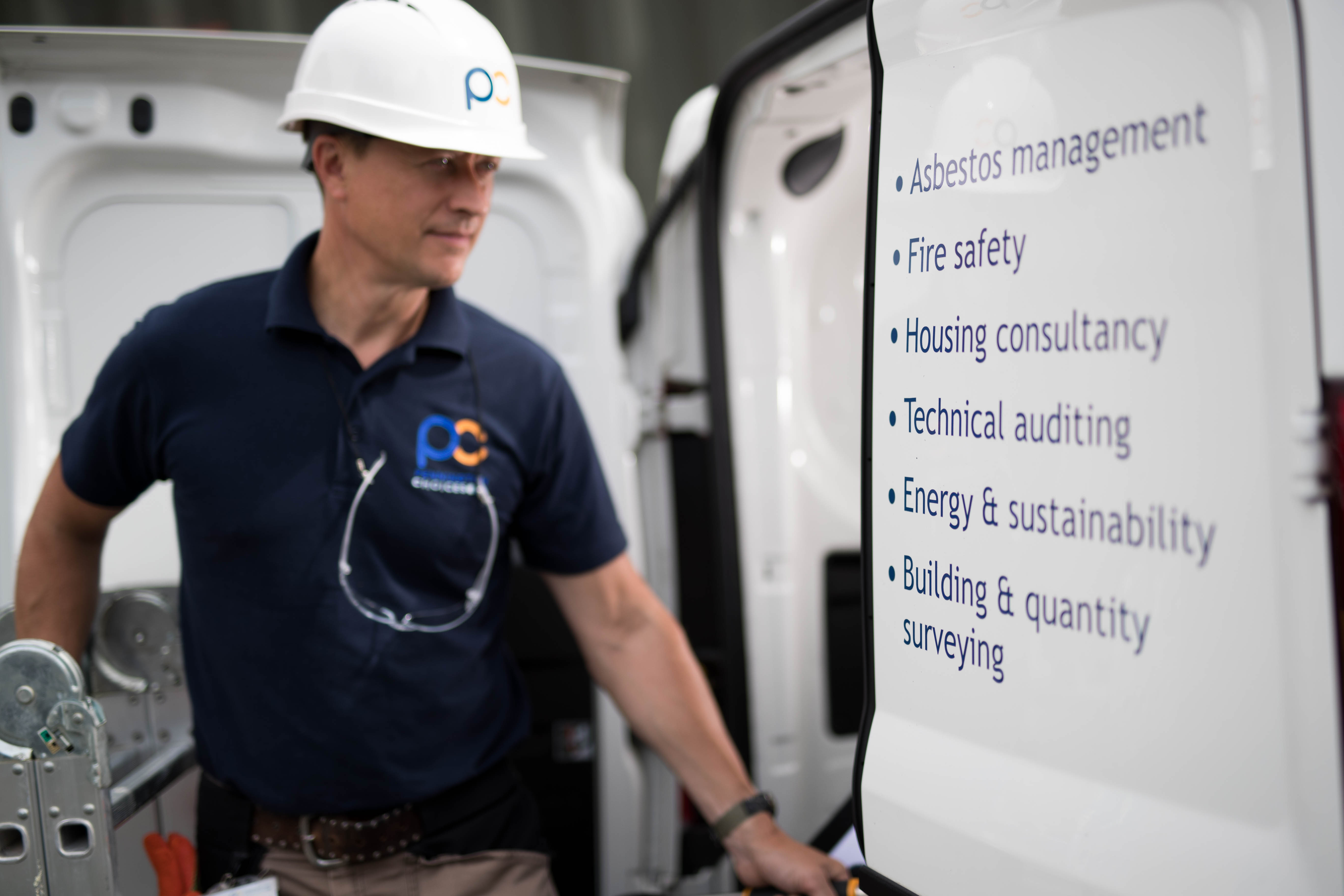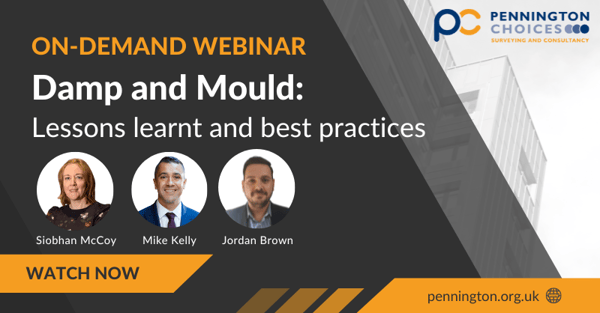Sign up to our newsletter
In our most recent damp and mould webinar - which you can watch on-demand here - we were joined by our panel of experts to talk through the latest updates surrounding damp and mould legislation, landlord’s responsibilities, and key lessons learnt from working with different organisations within the sector. This blog will outline the changes to damp and mould legislation and your responsibilities, whilst primarily focusing on the key issues that our experts have been finding and how they have developed approaches to combat these.
Upcoming Changes
The upcoming changes to damp and mould legislation include amendments to the Decent Homes Standard (DHS) and the Housing Health and Safety Rating System (HHSRS), with some significant changes being introduced by the Social Housing (Regulation) Act 2023 (the Act) which gained Royal Assent in July 2023.
Amongst the requirements the Act will introduce is a designated health and safety lead within social providers. This duty requires you to ensure you comply with all your health and safety obligations including those covering your employees, buildings, and tenants. Ensuring properties are free from damp and mould, as well as other hazards, is part of the health and safety duties that the designated lead will need to ensure you comply with. To read more about the requirements of the Social Housing (Regulation) Act 2023, read our blog here.
The government is also updating the Decent Homes Standard, and intends that it will apply across all rented tenures. The amendments will be across all four of the current criteria within the DHS:
- Updating the HHSRS (the housing health and safety rating system). Introducing a specific damp and mould standard, and bringing other physical decency requirements into the DHS
- Amending the disrepair criteria, including removing the requirement for something to be ‘old’ in order to be broken.
- Reviewing the list of essential facilities to include requirements around ventilation, home security, and other issues, as well as reviewing the ‘rule of three’ which allows for some essential facilities not to be met.
- Considering possible measures related to climate change and environmentally sustainable behaviours, including thermal comfort in homes, insulation requirements, and introducing Minimum Energy Efficiency Standards for the social rented sector.
- Changes to the HHSRS will bring it up to date to reflect modern expectations and living standards, reducing the 29 hazards to 21 and implementing ‘indicative baselines’ to enable an initial assessment to determine whether serious hazards are present.
To discover expert insight into the upcoming changes to the HHSRS and your damp and mould duties, catch up on our webinar, 'Preparing for Change: HHSRS, Damp, Mould, and Condensation', available to watch on-demand now.
Lessons learnt from the sector
Having worked with several organisations within the sector on their damp and mould approach, here are some examples of good practice we have found.
Clear governance with a structured approach
Good practice begins by having an established, comprehensive damp and mould policy and clear governance in place. Process maps which underpin a collaborative approach enables you to be clear on what you are delivering, ensuring that there is accountability between all teams and staffso everyone knows their role in addressing damp and mould. This will enable you to gather information from various sources such as service requests, complaints, housing officers, or scheme managers to ensure you recognise and act on potential indicators of damp and mould. These practices must be embedded within all service areas, rather than a one-off approach.
From a reactive approach to a proactive approach
Organisations are shifting from a reactive approach to a more proactive one. You should no longer be solely relying on tenants to report damp and mould issues as you should have the mechanisms and ability to identify potential hotspot areas, susceptible properties, and vulnerable tenants.
There have been significant changes in thinking around meeting the Decent Homes Standard and assessing HHSRS hazards, especially around opening windows as the main way to ventilate, to using mechanical or passive ventilation. This is representative of a forward-thinking approach that we are seeing in good organisations as they are working to reduce reactive cases and proactively improving ventilation and reducing the risk to customers.
Collection of data
Efficient use of accurate and up-to-date asset data is crucial in highlighting where you may have issued, and gaining an understanding of the quality of your stock.
The Regulator of Social Housing is consulting on the new consumer standards, and has made it clear that knowing your assets is not just about undertaking five-year rolling stock condition programmes. A more sophisticated approach to gathering stock condition and baseline data is required, building on it and using other data from repairs, investment programmes and resident feedback, so you can identify areas where your data is not robust enough and strengthen it. For example, when developing investment plans in properties, it would be wise to take the opportunity to refresh the stock condition data simultaneously, linking to investment plans and improving living standards and affordability for customers.
Leveraging IT systems can help you gain better oversight, management, and reporting on potential issues and how to solve them. You should be harnessing information you are gathering to develop robust investment plans address whole-property issues. You also need to ensure you have assurance that you are identifying issues and addressing them. Good practice within the sector includes using a structured approach to reporting: picking up the number of cases, jobs outside of timeframes, and reporting going through to boards, so you have oversight of performance – what gets measured gets done!
Communication is key
To implement a whole organisation approach, your frontline staff members who visit customers must have basic training to understand the fundamentals of damp, mould, and condensation so they can identify the signs and issues, and can report back to the relevant people early and efficiently. You should foster a culture of open communication with staff members so you can identify if they need more training and so they can feed back information on what they see when speaking to or visiting residents. If you find complex issues with your assets, which are outside your skillsets, you also need to be open to communicating with external organisations to form a collaborative, efficient approach.
Additionally, maintaining communication with tenants is key to sustaining an effective approach. This involves informing your tenants about existing measures and regularly updating them. By educating your tenants on the cause and identification of damp and mould, you will empower them to proactively identify any potential issues, as well as keep you informed on the success of action you have taken. Providing ongoing monitoring and follow-up consultations, particularly approaching colder weather, for damp, mould, and condensation issues, is a way to help keep hazards at bay. Your focus must be on the long-term solution, rather than just the current numbers of cases you are dealing with, by putting measures in place to eradicate the issue at the root cause, then maintaining communication to facilitate periodic checkups thereafter.
Damp and mould surveys
We have developed a three-tiered approach to allow clients the flexibility to choose the service that best fits their requirements at any given time.
- Tier 1 - Visiting a property to identify the existence of damp and mould.
- Tier 2 – Includes all aspects of tier 1, plus an investigation into the entire exterior and interior of a property, rather than just the issue that was raised by a tenant which may be in a limited area. In this stage, we look at the whole property holistically, including the construction and current condition of the building. This identifies the root cause of the issue, as well as providing a tangible action for the client to carry out to resolve it.
- Tier 3 – Includes all aspects of tiers 1 and 2, plus an assessment of the whole property archetype. Here, we deep dive into the specific archetypes of buildings to investigate whether the hazard may be present in other similar properties so you can take wider proactive action.
Ultimately, the process of managing and maintaining buildings is ever-changing. We have seen this through the best practices we have developed from working with organisations over the last eight months alone. Therefore, operational and strategic responses must continue to adapt and evolve to align with legislative and regulatory changes, whilst learning from good practice.
You can watch the full webinar on-demand here.







